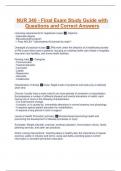NUR 340 - Final Exam Study Guide with
Questions and Correct Answers
Licensing requirements for registered nurses ✅- Diploma
- Associate degree
- Baccalaureate program
→ Pass NCLEX **administered & licensed by state**
Oversight of practical nurses ✅LPNs work under the direction of a healthcare provider
or RN to give direct care to patients, focusing on meeting health care needs in hospitals,
long-term care facilities, and home health facilities.
Nursing roles ✅- Caregiver
- Communicator
- Teacher/educator
- Counselor
- Leader
- Researcher
- Advocate
- Collaborator
Classification of illness ✅Acute: Rapid onset of symptoms and lasts only a relatively
short time.
Chronic: Usually have a slow onset & can have periods of remission or exacerbation
Encompasses a number of different physical and mental alterations in health, each
having one or more of the following characteristics:
- It is a permanent change.
- It causes, or is caused by, irreversible alterations in normal anatomy and physiology.
- It requires special patient education for rehabilitation.
- It requires a long period of care or support
Levels of Health Promotion (primary) ✅Directed toward promoting health and
preventing the development of disease processes or injury
Examples: Weight loss/diet, exercise, smoking cessation, immunization clinics, family
planning services, and safer sex practices.
Direct nursing interventions: Teaching about a healthy diet, the importance of regular
exercise, safety in industry and farms, using seat belts, providing poison-control
information or accident-prevention education.
,Levels of Health Promotion (secondary) ✅Focus on screening for early detection of
disease with prompt diagnosis and treatment of any found. (Proposals to repeal the
ACA are placing these preventive care options in jeopardy)
Examples: Assessing children for normal growth & development, encouraging regular
medical, dental, and vision examinations. Screenings (blood pressure, cholesterol, skin
cancer), recommending gynecologic examinations & mammograms for women at
appropriate ages, and teaching breast/testicular self-examination
Direct nursing interventions: Performing screenings, administering medications, &
caring for wounds.
Sociocultural dimensions of health and illness ✅Health practices & beliefs are strongly
influenced by the person's economic level, lifestyle, family, & culture.
In general, low-income & underserved populations are less likely to seek medical care
to prevent illness and have fewer treatment options.
Levels of Health Promotion (tertiary) ✅Begins after an illness is diagnosed & treated,
with the goal of reducing disability and helping rehabilitate patients to a maximum level
of functioning
Examples: Teaching a patient with diabetes how to recognize and prevent
complications, using physical therapy to prevent contractures in a patient who has had a
stroke or spinal cord injury, and referring a woman to a support group after removal of a
breast because of cancer
Direct nursing interventions: Monitor patient response, provide services to facilitate
recovery or improve quality of life.
Maslow hierarchy ✅Physiologic - Most basic needs (food, water, oxygen, rest,
sexuality, physical activity, elimination, temp)
Safety & Security - Physical/emotional components (hand hygiene/aseptic techniques,
explaining new & unfamiliar procedures/treatments)
Love and Belonging Needs - Acceptance/receiving love (including family in care, referral
to support groups)
Self-Esteem Needs - How a person feels about themselves (promote self-worth & self-
acceptance, feelings)
Self-Actualization Needs - Spirituality/intellectual, acceptance of self & others,
happiness & affection (teach to maximize potentials; religion)
Lower levels must be met first
, Health promotion and maintenance ✅Nursing interventions to promote family health:
- Assisting person & family with basic needs
- Accident prevention, sex education, BP screenings, etc
Family structures ✅Nuclear family: traditional family; two parents and their children
Extended family: includes aunts, uncles and grandparents
Blended family: two parents and their unrelated children from previous relationships
Single-parent family: may be separated, divorced, widowed, or never married
Cohabiting: unmarried adults living together and communal or group marriages
The community ✅Definition: Is a specific population or group of people living in the
same geographic area under similar regulations and having common values, interests,
and needs.
- Identified as a potential factor in health disadvantages in the US
Characteristics:
- Prevailing values & beliefs
- Health care resources
- Transportation & communication facilities
- Education & recreation programs
- Production of service & goods
- Protection, safety, & aesthetic concerns
Community Factors and Influences Affecting Health ✅- Social support systems
- Community health care structure
- Economic resources
- Environmental factors
- Effect on individuals & families
- Nursing in the community
- Community health nursing: Focus on whole populations
- Community-based nursing: Focus on members of the population
Cultural blindness ✅Ignores differences and proceeds as if they did not exist
Stereotyping ✅- The assumption that all members of a culture or ethnic group act alike
- May be positive or negative
- Mistaken beliefs that lead to discrimination
- Negative includes racism, ageism, and sexism




